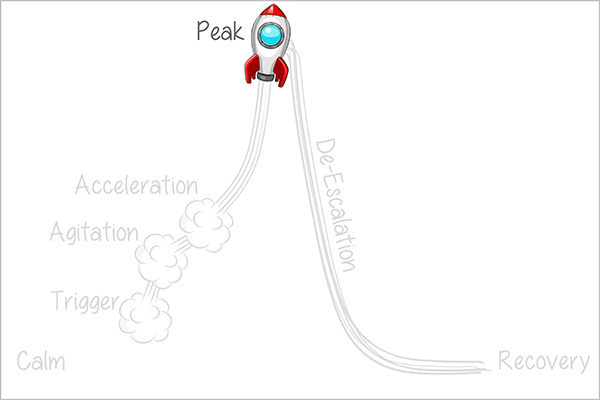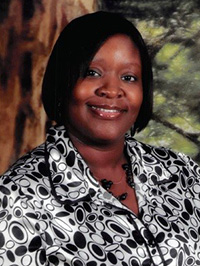How can educators recognize and intervene when student behavior is escalating?
Page 7: Peak
 If the teacher is unable to defuse a student’s behavior during the Acceleration Phase, the student will move into the Peak Phase—the most unpredictable and often dangerous phase. During this phase, the teacher should focus on addressing disruptive acting-out behavior and maintaining safety.
If the teacher is unable to defuse a student’s behavior during the Acceleration Phase, the student will move into the Peak Phase—the most unpredictable and often dangerous phase. During this phase, the teacher should focus on addressing disruptive acting-out behavior and maintaining safety.
What a Student Looks Like
In this phase, the student may engage in behaviors that disrupt the learning environment and result in lost instructional time. In some cases, the student’s behavior may be clearly out-of-control and even pose a danger to themselves and others.
Disruptive Behaviors
- Yelling at the teacher or another student
- Swearing
- Throwing a book on the floor
- Slamming the door
- Walking out of the classroom
Dangerous Behaviors
- Hitting others
- Throwing a book at a student or the teacher
- Engaging in self-harm
- Overturning a desk
- Running out of the room or the school
The behavior at this point is often loud and explosive. Although the Peak Phase tends to be a short one, the aftermath of this critical event, or “behavioral earthquake,” is usually quite serious. For obvious reasons, it is best to prevent behaviors from escalating to this point.
Strategies To Implement
In this phase, the teacher can no longer prevent the challenging behavior. Teachers can implement the following strategies to address out-of-control behavior when it occurs.
| Strategy | Tips |
| Maintain self-control. |
|
| Have a plan and know how to implement it. |
x
Crisis plans Explicit steps for obtaining immediate assistance for serious behavioral situations. For example:
x
Restraint A physical restriction that prevents or limits a student’s ability to move parts of the body (e.g., head, arms, legs) freely. x
Seclusion The placement of a student alone in a room or area from which he is physically unable to leave. Note: Timeout is not a form of seclusion. Note: You should be familiar with your school or district’s policy on restraint and seclusion . These practices should be used only as a last resort and only by trained personnel. |
In this video, Nora displays some common Peak Phase behaviors. Note how Mr. Santini maintains control and implements his crisis plan (time: 2:38).
Transcript: Peak Phase
Teacher: Last call for questions? Otherwise, we’re going to get started on today’s warm-up.
Nora: [pushes over chair] You’re so annoying! I hate this class!
Teacher: [To another student] Take this to Ms. Chen, please.
Teacher: [To class] Class, let’s line up at the door and go next door to Ms. Chen’s just like we practiced.
[ Johanna Staubitz commentary ]
To his great credit, Mr. Santini notices relatively quickly that Nora’s behavior has reached peak or crisis level. And we know that because she has now become disruptive to property and aggressive toward property. And so a teacher’s first priority at this point is to keep everybody safe. So what Mr. Santini does is you can see him here handing off a crisis card that communicates to a nearby teacher that they will be absorbing his class for a while, while the situation is brought under control. So a student takes this to another teacher and then the class files out and you’ll notice that they filed out in an orderly manner, and which suggests they’ve practiced this before. So a really important part of any classroom management plan is to teach and have students practice—and I consider that part of teaching—what to do in a crisis or a safety or crisis plan. It’s called different things in different places.
So a safety or crisis plan, in teaching it, you know, Mr. Santini didn’t need to say, “Oh, if Nora or, you know, Jordan, or some other student in the room gets dangerous this is what you’ll do.” There are a lot of scenarios in which something like this can be helpful, including a fire drill, right? So we need to teach procedures for students to exit the room safely, and so they do that. And, again, it’s important that stuff is taught in advance. After that happens, you’ll see that or you saw that Mr. Santini gives Nora some space; he doesn’t approach her, he just waits. He’s still in the room, even though the class has gone to another teacher’s room.
But he doesn’t interact with Nora and what she does is kind of her behavior peters out. She stops kicking and pushing things, and eventually sits down on the floor.
Unlike in previous phases, once a student enters the Peak Phase, the teacher can no longer interrupt the acting-out cycle. To return to the Calm Phase, the teacher must support the student as he or she transitions through the De-escalation and Recovery Phases.
Kathleen Lane provides more information about implementing a pre-established plan and prioritizing safety during the Peak Phase. Next, Pamela Glenn and Janel Brown share examples of responding to peak behaviors.

Kathleen Lane, PhD, BCBA-D
Professor
Department of Special Education
Associate Vice Chancellor for Research
University of Kansas
(time: 2:00).
Transcript: Kathleen Lane, PhD, BCBA-D
The overriding consideration during this peak phase of the acting-out cycle is to maintain safety of the student who is acting out as well as the other students that are there in the classroom, the teacher, and the other adults as well, to ensure that nobody is going to get hurt. In order to do that, we first need to figure out long before this ever happens, ideally before the first day of school, what the plan is going to be. So in some schools, they’ll have the students who are in control line up outside the classroom and wait outside the door. And oftentimes they’ll call a vice principal or somebody else that manages challenging behaviors to come and remove the student who is engaging in this peak behavior. So there’s a variety of different methods that people can use. And what’s important for the teacher before the first day of school is to figure out how does your school’s set of leaders want you to respond to those types of problems? Is the goal to keep all the students in the classroom? Is the goal to remove the student who’s acting out? Do you have a removal policy at that point where they will send the student to on-campus suspension or phone a parent? The downside of that, though, I have to say, is that you can unintentionally reinforce this really undesirable behavior. So if you send a student out, you can be [laughs] teaching them that if you act out significantly enough, you can escape my classroom or these task demands or these assignments. And so if that student’s particular goal is to get out of a situation that they’re not comfortable with either because they can’t do or don’t want to do these activities or whatever is taking place in class, you are in danger of reinforcing some very inappropriate behavior.
So we have to be careful here. We want to think about what is the child trying to get or trying to avoid when they’re in that peak behavior? We want to get through this peak stage as quickly as possible and get out of it so that we can restore the environment, recover, debrief with that student, and get back on track instructionally. But we have to keep everybody safe.
Transcript: Pamela Glenn
The students know my first and primary role is I promised your parents I would keep you safe. If I have to get 23 students out of the room so that 24th student can lose it, then that’s what we do. I’m thinking of a couple of instances where a student has been throwing furniture, and the first thing I’m going to do is I’m clearing everybody out of the room and they know, let’s go. I think the important thing is you keep calm so that the students keep calm, and the student who is acting out is also calm within their crisis. And I’m going to put myself between the students and the student. I’m thinking of the few cases where that’s happened, and the kids will just leave the room quickly. I would encourage teachers to befriend a peer teacher so that if you need a timeout, send [laughs] Johnny out for a minute so you can calm down. Because sometimes it’s not about the student calming down, it’s about you calming down. I’ve had the students leave and go to the next classroom so I can then come back and keep an eye and then you buzz for administration, and somebody’s going to come. Typically, where I’ve experienced this, once peaks hit, the student’s in it to win it. They’ve already thrown the chair, they’re not thinking rationally. Once the chair’s left their hand or the table’s left their hand or the pencil’s left their hand, you immediately see “Oh, my gosh, what have I done?” And then usually it’s followed by tears, remorse, or even saving face. I haven’t experienced it be something that’s just kept going. It’s been an isolated incident of something followed by “I shouldn’t have done that.” If they’ve said it or not, they’re telling you physically or they’re telling you with their words. Then it’s down to keep everybody away. We’re not going to worry about why it happens at that moment. Let’s just get you safe. Let’s get you out of here. “Do you need to speak with me? Do you need to speak with the guidance counselor? Who do you want to speak to that’s going to get you back to that safe place?”
If somebody is peaked and it’s not causing physical harm to everybody else, then the rest of the room knows, “No, we’re ignoring.” And that’s a really hard skill to teach kids, especially the little kids. However, if you do it from day one; I tell the students all the time, if you feed it, it will grow. So, when the student that’s looking for that attention is getting up there and they sometimes will peak because they’re not getting any attention, you ignore it. You turn your head. You turn your body. All of that, just ignore it.
Transcript: Janel Brown
There have been times when it got to the point where the teacher and the students will remove themselves. She will be standing at the door, but the kids are out, and she will be standing at the door because she couldn’t leave either group of students: these students or the single student alone. So for her, she had a courtyard right here so the kids could sit, but the kid who was at that point was in the classroom. And once we got there, we had nails flying, we’ve had scissors flying because he found a way to pop them apart. So now the scissors became frisbees. But, you stand there and if you do not feed into what the child is doing, eventually he will calm down enough where someone could talk to him. And then at that point, “Okay, Johnny, are you ready to tell me what happened?” Sometimes they will. Sometimes they won’t.
We had another little boy when he couldn’t get his way, his peak phase, extremely loud, just yelling at the top of his lungs to the point where his voice is so hoarse when he’s done. He would just scream, yelling, curse words, “I hate you. Leave me alone.” And you just stand there. But, like I said before, if you don’t feed into him when he’s saying all of this, you just stand there and you look at him and you listen, when he sees that you’re not going to react to his behavior, he calms down. You don’t have to say anything. You don’t have to do anything because he’s not getting that attention. He does it with a teacher because he knows the teacher is gonna, “Oh, Scotty, don’t do this” or “Scotty, you can’t do this.” That’s just a normal reaction. But we just kind of stand there and look, and when he calms down, “Are you done?” and “What happened? Explain to us what happened. How could you have done this differently or that differently? Do you understand the destruction in your classroom? Now no one is learning. How does that make you feel?”
For Your Information
For students who repeatedly engage in the acting-out cycle, a functional behavioral assessment (FBA) can help teachers identify triggers and develop a plan for support. To learn more about this, see the IRIS Module:
Activity
Kai’s behavior in the Peak Phase is illustrated in the video below.
Transcript: Peak Phase
[Kai gets up out of his seat and pushes the papers off his desk.]
Kai: Leave me alone! [runs out of classroom]
Teacher: Class, please continue with your reading [looks out the classroom door].
Teacher: [[picks up the classroom phone] Hi. Kai is headed towards the cafeteria. Thank you. [hangs up phone]
After reviewing, answer the following questions. You may type your answers in the field below the video. However, this field is provided for reflection purposes only; your answers will not be available for download or printing.
- What procedure did Mr. Santini use when Kai eloped from the room?
- Why is it important to have this plan in place before this type of behavior occurs?
Now that you’ve had a chance to reflect, listen to Johanna Staubitz’s feedback (time: 1:33).

Johanna Staubitz, PhD, BCBA-D
Assistant Professor
Department of Special Education
Vanderbilt University
Transcript: Johanna Staubitz
So, Kai has run out of the classroom at this point. This is Peak in his escalation cycle, and this is a dangerous behavior because we don’t have control over what happens to Kai. Outside this room, you could leave the building, so it’s very important that Mr. Santini addresses the situation immediately. What Mr. Santini does is goes to the phone, picks up, calls the front office, specifies who has left the classroom and in what direction he headed. Clearly, Mr. Santini already knew what to do in a situation like this or he wouldn’t have been able to react so fluently. And it’s really important for you if, well not if, you should assume that at some point a student may elope from your classroom run out, or engage in dangerous behavior inside your classroom, and you’ve got to have that safety or crisis plan. That plan should be determined through conversation with your administrators. There are often school policies that dictate whether you step out into the hallway so you can supervise the student who ran as well as your classroom, whether you stay in the room with your class and someone else goes after the child, or how the class needs to leave the room if the behavior problem happens inside the classroom. So again, it’s really important for you to know in advance how to deal with dangerous behavior and determine that plan in conjunction with schoolwide policies. Not only is it important for you to know it and be ready to enact your role in that plan, but often the students in your room have a role in a crisis plan, and they need to be aware of the plan and have practiced enacting it as well.

